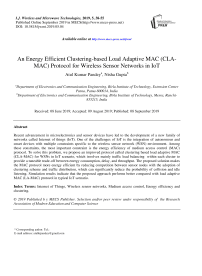An energy efficient clustering-based load adaptive MAC (CLA-MAC) protocol for wireless sensor networks in IoT
Автор: Atul Kumar Pandey, Nisha Gupta
Журнал: International Journal of Wireless and Microwave Technologies @ijwmt
Статья в выпуске: 5 Vol.9, 2019 года.
Бесплатный доступ
Recent advancement in microelectronics and sensor devices have led to the development of a new family of networks called Internet of things (IoT). One of the challenges of IoT is the integration of autonomous and smart devices with multiple constraints specific to the wireless sensor network (WSN) environment. Among these constraints, the most important constraint is the energy efficiency of medium access control (MAC) protocol. To solve this problem, we propose an improved protocol called clustering based load adaptive MAC (CLA-MAC) for WSNs in IoT scenario, which involves mainly traffic load balancing within each cluster to provide a tuneable trade-off between energy consumption, delay, and throughput. The proposed solution makes the MAC protocol more energy efficient by reducing competition between sensor nodes with the adoption of clustering scheme and traffic distribution, which can significantly reduce the probability of collision and idle listening. Simulation results indicate that the proposed approach performs better compared with load adaptive MAC (LA-MAC) protocol in typical IoT scenario.
Internet of Things, Wireless sensor networks, Medium access control, Energy efficiency and clustering
Короткий адрес: https://sciup.org/15016980
IDR: 15016980 | DOI: 10.5815/ijwmt.2019.05.04
Список литературы An energy efficient clustering-based load adaptive MAC (CLA-MAC) protocol for wireless sensor networks in IoT
- Yinbiao, Shu, et al., Internet of things: wireless sensor networks, White Paper, International Electrotechnical Commission, Available from: http://www. iec. Ch, 2014: 11.
- Mainetti, Khalil, Nacer, et al., Wireless sensors networks for Internet of Things, ninth international conference on Intelligent sensors, sensor networks and information processing (ISSNIP), IEEE, 2014.
- Adhikari, Ratnadip. A meticulous study of various medium access control protocols for wireless sensor networks, Journal of Network and Computer Applications 41, 2014: 488-504.
- Bougard, Bruno, et al., Energy efficiency of the IEEE 802.15. 4 standard in dense wireless microsensor networks: Modeling and improvement perspectives, Proceedings of the conference on Design, Automation and Test in Europe-Volume 1. IEEE Computer Society, 2005.
- Jha, Manish Kumar, et al., An energy-efficient multi-layer MAC (ML-MAC) protocol for wireless sensor networks, AEU-International Journal of Electronics and Communications 65.3, 2011: 209-216.
- Jang B. et al, An Asynchronous Scheduled MAC Protocol for Wireless Sensor Networks, Computer Networks, 2013, No. 57, Vol. 1, pp 85-98.
- Dinh T. et al, L-MAC: A Wake-up Time Self-Learning MAC Protocol for Wireless Sensor Networks, Computer Networks, 2016, vol. 105, pp 33-46.
- Bhatia A. et al, TRM-MAC: A TDMA-based Reliable Multicast MAC Protocol for WSNs with Flexibility to Trade-off between Latency and Reliability, Computer Networks, 2016, vol. 104, pp 79–913.
- Raja, P., and P. Dananjayan, Game theory based energy efficient hybrid MAC Protocol for lifetime enhancement of wireless sensor network, Iranian Journal of Electrical and Electronic Engineering 10.1, 2014: 10-17.
- Crosby, Garth V., and Farzam Vafa., Wireless sensor networks and LTE-A network convergence, Local Computer Networks (LCN), 2013 IEEE 38th Conference On. IEEE, 2013.
- Laya, Andres, Luis Alonso, and Jesus Alonso-Zarate, Is the Random Access Channel of LTE and LTE-A Suitable for M2M Communications? A Survey of Alternatives, IEEE Communications Surveys and Tutorials 16.1, 2014: 4-16.
- Liu, Yi, et al., Design of a scalable hybrid MAC protocol for heterogeneous M2M networks, IEEE Internet of Things Journal 1.1, 2014: 99-111.
- Aijaz, Adnan, et al., Energy-efficient uplink resource allocation in LTE networks with M2M/H2H co-existence under statistical QoS guarantees, IEEE Transactions on Communications 62.7, 2014: 2353-2365.
- Banerjee, Bitan, et al., BSMAC: A hybrid MAC protocol for IoT systems, Global Communications Conference (GLOBECOM), IEEE, 2016.
- Roy, Swati Sucharita, et al., Building a Sustainable Internet of Things: Energy-Efficient Routing Using Low-Power Sensors Will Meet the Need, IEEE Consumer Electronics Magazine 7.2, 2018: 42-49.
- Hamrioui, Sofiane, and Pascal Lorenz., Efficient medium access protocol for Internet of things applications, International Journal of Communication Systems 30.10, 2017: e3227.
- Kiran, M. Pavana Ravi Sai, Y. R. V. Prasad, and Pachamuthu Rajalakshmi., Modeling and Analysis of IEEE 802.15. 4 Multi-hop Networks for IoT Applications, Wireless Personal Communications 100.2, 2018: 429-448.
- Mroue, Hussein, et al., MAC layer-based evaluation of IoT technologies: LoRa, SigFox and NB-IoT, Communications Conference (MENACOMM), IEEE Middle East and North Africa. IEEE, 2018.
- Kumarawadu, Priyantha, et al., Algorithms for node clustering in wireless sensor networks: A survey, Information and Automation for Sustainability, 2008. ICIAFS 2008. 4th International Conference on. IEEE, 2008.
- Rigazzi, Giovanni, et al., Aggregation and trunking of M2M traffic via D2D connections, Communications (ICC), 2015 IEEE International Conference on. IEEE, 2015.
- Sadek, Rowayda A., Hybrid energy aware clustered protocol for IoT heterogeneous network, Future Computing and Informatics Journal, 2018.
- Heinzelman, Wendi Rabiner, Anantha Chandrakasan, and Hari Balakrishnan. "Energy-efficient communication protocol for wireless microsensor networks." In Proceedings of the 33rd annual Hawaii international conference on system sciences, pp. 10-pp. IEEE, 2000.
- R. Rom and M. Sidi, Multiple access protocols: performance and analysis. Springer Science and Business Media, 2012.


